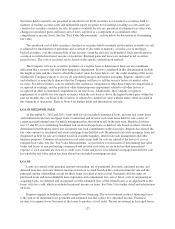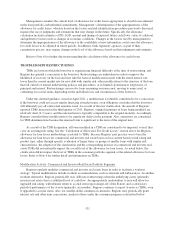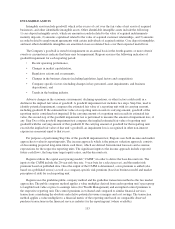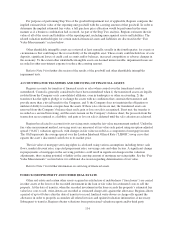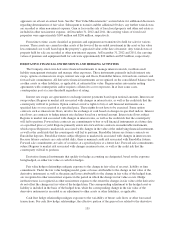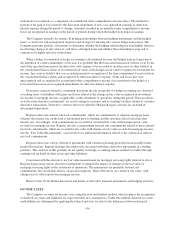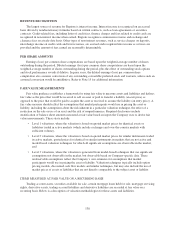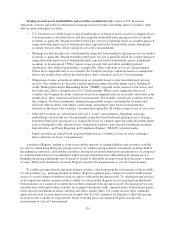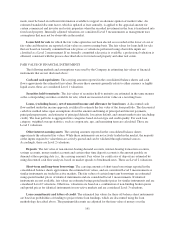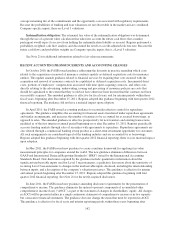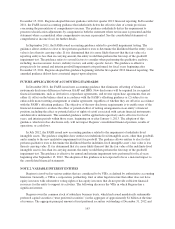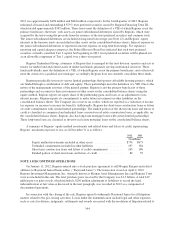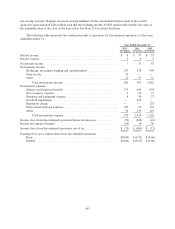Regions Bank 2012 Annual Report Download - page 151
Download and view the complete annual report
Please find page 151 of the 2012 Regions Bank annual report below. You can navigate through the pages in the report by either clicking on the pages listed below, or by using the keyword search tool below to find specific information within the annual report.appraisers on at least an annual basis. See the “Fair Value Measurements” section below for additional discussion
regarding determination of fair value. Subsequent to transfer and the additional 60 days, any further write-downs
are recorded as other non-interest expense. Gain or loss on the sale of foreclosed property and other real estate is
included in other non-interest expense. At December 31, 2012 and 2011, the carrying values of foreclosed
properties were approximately $149 million and $296 million, respectively.
From time to time, assets classified as premises and equipment are transferred to held for sale for various
reasons. These assets are carried in other assets at the lower of the recorded investment in the asset or fair value
less estimated cost to sell based upon the property’s appraised value at the date of transfer. Any write-downs of
property held for sale are recorded as other non-interest expense. At December 31, 2012 and 2011, the carrying
values of premises and equipment held for sale were approximately $20 million and $33 million, respectively.
DERIVATIVE FINANCIAL INSTRUMENTS AND HEDGING ACTIVITIES
The Company enters into derivative financial instruments to manage interest rate risk, facilitate asset/
liability management strategies and manage other exposures. These instruments primarily include interest rate
swaps, options on interest rate swaps, interest rate caps and floors, Eurodollar futures, forward rate contracts and
forward sale commitments. All derivative financial instruments are recognized on the consolidated balance sheets
as other assets or other liabilities, as applicable, at estimated fair value. Regions enters into master netting
agreements with counterparties and/or requires collateral to cover exposures. In at least some cases,
counterparties post at a zero threshold regardless of rating.
Interest rate swaps are agreements to exchange interest payments based upon notional amounts. Interest rate
swaps subject Regions to market risk associated with changes in interest rates, as well as the credit risk that the
counterparty will fail to perform. Option contracts involve rights to buy or sell financial instruments on a
specified date or over a period at a specified price. These rights do not have to be exercised. Some option
contracts such as interest rate floors, involve the exchange of cash based on changes in specified indices. Interest
rate floors are contracts to hedge interest rate declines based on a notional amount. Interest rate floors subject
Regions to market risk associated with changes in interest rates, as well as the credit risk that the counterparty
will fail to perform. Forward rate contracts are commitments to buy or sell financial instruments at a future date
at a specified price or yield. Regions primarily enters into forward rate contracts on marketable instruments,
which expose Regions to market risk associated with changes in the value of the underlying financial instrument,
as well as the credit risk that the counterparty will fail to perform. Eurodollar futures are futures contracts on
Eurodollar deposits. Eurodollar futures subject Regions to market risk associated with changes in interest rates.
Because futures contracts are cash settled daily, there is minimal credit risk associated with Eurodollar futures.
Forward sale commitments are sales of securities at a specified price at a future date. Forward sale commitments
subject Regions to market risk associated with changes in interest rates, as well as the credit risk that the
counterparty will fail to perform.
Derivative financial instruments that qualify for hedge accounting are designated, based on the exposure
being hedged, as either fair value or cash flow hedges.
Fair value hedge relationships mitigate exposure to the change in fair value of an asset, liability or firm
commitment. Under the fair value hedging model, gains or losses attributable to the change in fair value of the
derivative instrument, as well as the gains and losses attributable to the change in fair value of the hedged item,
are recognized in other non-interest expense in the period in which the change in fair value occurs. Hedge
ineffectiveness is recognized as other non-interest expense to the extent the changes in fair value of the derivative
do not offset the changes in fair value of the hedged item. The corresponding adjustment to the hedged asset or
liability is included in the basis of the hedged item, while the corresponding change in the fair value of the
derivative instrument is recorded as an adjustment to other assets or other liabilities, as applicable.
Cash flow hedge relationships mitigate exposure to the variability of future cash flows or other forecasted
transactions. For cash flow hedge relationships, the effective portion of the gain or loss related to the derivative
135




